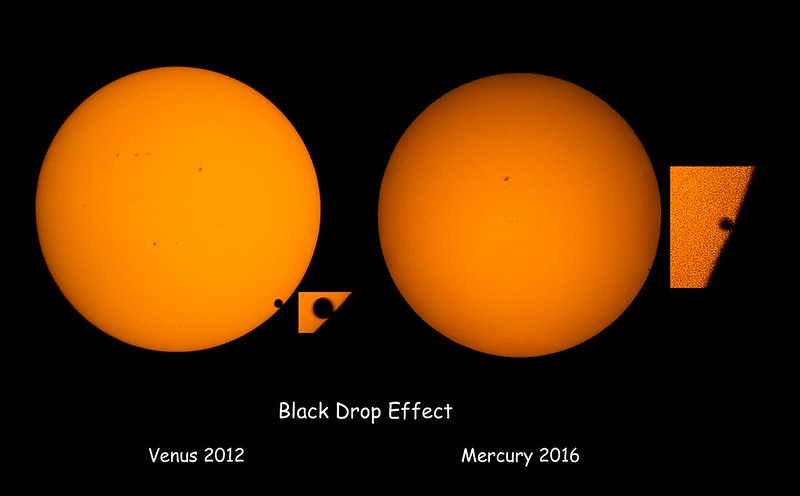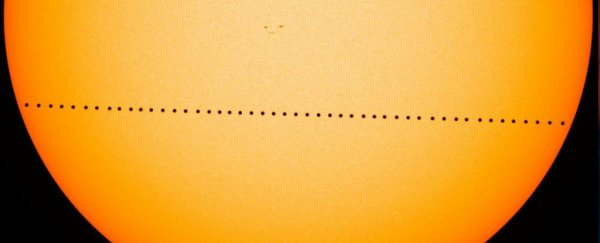One of the finest spectacles in astronomy is to witness the passage of one object in front of another. This can transpire as an eclipse, an occultation, or a rare event known as a planetary transit.
We get a shot at seeing just such a singular event next Monday on 11 November, as a transit of Mercury across the face of Sol occurs for the last time this decade.
The event and who will see it: the duration for the transit is a leisurely 5 hours, 28 minutes and 47 seconds. The event is well placed for South America and eastern North America, which will witness the transit in its entirety. Western North America will seeing the transit in progress at sunrise, while Africa, Europe and the Middle East will see the transit underway at sunset.
Keep in mind, watching the transit low to the horizon near sunrise or sunset will also give photographers a chance to catch the Sun, plus the 'shadow' outline of Mercury along with the silhouettes of foreground objects on the horizon, making for a very photogenic spectacle. Only Australia and eastern/central Asia will miss out.
Our handy graphic gives transit times in UT (Universal Time):
 The November 11th 2019 transit of Mercury. (Xavier Jubier)
The November 11th 2019 transit of Mercury. (Xavier Jubier)
Weather prospects
First, the good news: you don't need a perfectly clear sky to see the transit: just a good view of the Sun. As of writing this, weather prospects for the US Eastern Seaboard are a bit touch and go. We should have a better grab on just what the skies are going to do come Monday going into this weekend.
Observing a transit of Mercury is a unique event, requiring adequate preparations versus an eclipse or transit of Venus. Mercury is tiny: during the transit, the disk of the innermost world will appear only 10″ across.
This means you'll need magnification coupled with solar observing safety protocols, the same precautions as you'd take to observe a partial solar eclipse; simple pinhole projection or solar eclipse glasses won't cut it.
If you have a hydrogen-alpha telescope or a telescope equipped with a white-light filter for solar observing, you're all set. One method we've used is to construct a binocular filter mask, using a tea box and a pair of repurposed eclipse glasses:

Be sure to watch for the elusive 'black drop' effect during the ingress and egress phases of the event. This phenomenon is more pronounced during Venus transits, but has been occasionally reported during Mercury transits as well.
 The 'black drop effect'. (Eliot Herman)
The 'black drop effect'. (Eliot Herman)
Venus transited the Sun twice in the 21st century: once in 2004 and again in 2012. Venus won't transit the Sun again until 2117.
Will we have a spotless Sun for the event? As of writing this, the possibility seems quite probable, as we're in the depths of a profound solar minimum. We had one tiny sunspot group crossing the face of Sol this past weekend, which has since disappeared.
Again, as with weather, we should have a good grasp on if the Sun will be spotless come transit day going into this weekend. Sunspots not only add to the photographic composition during a transit, but it also gives an observer something to focus on and show off to the public prior to the start.
Mercury Transits: Past, Present and Future
Pierre Gassendi successfully made the first observation of a transit of Mercury on 7 November 1631. This was actually the first reliable observation of a transit.
On average, we get roughly a transit of Mercury once per decade. There are 14 transits of Mercury in the 21st century, though we're about to enter a dry spell, with the next transit of Mercury occurring on 13 November 2032. Note that this is also the last transit of Mercury visible from North America until 2049.
In our current epoch, Mercury transits always occur either in May or November.
Happen to be visiting the Apollo 11 landing site on 13 November 2236 AD? Then you can witness a truly bizarre spectacle: Mercury transiting the Sun during a solar eclipse:

Clouded out or live on the wrong side of the planet? You can watch the transit live courtesy of the Virtual Telescope Project.
Also transit science is afoot thanks to the Citizen ToM (Transit of Mercury), Using Citizen CATE gear from the 2017 total solar eclipse, as student groups plan to replicate the historic measurement of the astronomical unit using the transit.
Don't miss next Monday's transit, and the rare chance to watch the celestial clockwork motion of the heavens in action.
This article was originally published by Universe Today. Read the original article.
